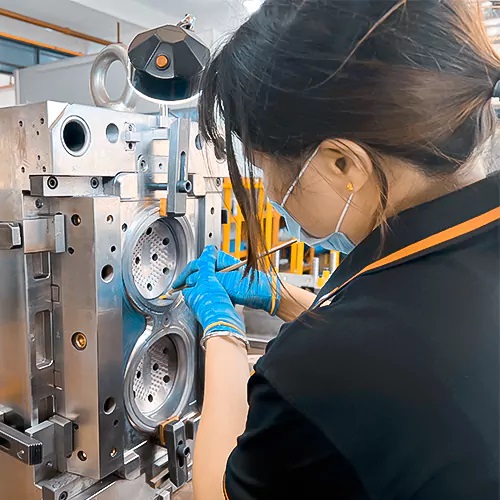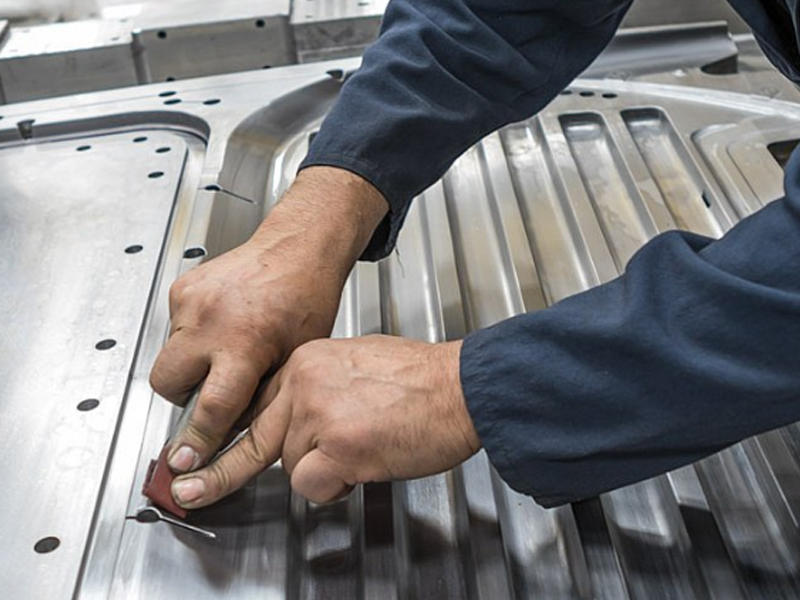
Mold polishing has two purposes; One is to increase the smoothness of the mold, making the surface of the product produced by the mold smooth, beautiful, and aesthetically pleasing. The other is to make it easy to demold the mold, so that the plastic does not stick to the mold and cannot be removed. Mold polishing is generally the process of using oilstone, sandpaper, polishing paste, etc. to polish the surface of the mold cavity, so that the working surface of the mold can be as bright as a mirror, which is called mold polishing.
Do not use the finest oilstone, sandpaper, or polishing paste at the beginning of mold polishing, as it will not discard the coarse patterns. The polished surface looks very shiny, but when viewed from the side, coarse patterns become apparent. Therefore, it is necessary to first polish with coarse oilstone, sandpaper, or grinding and polishing paste, then switch to finer oilstone, sandpaper, or grinding and polishing paste for polishing, and finally use the finest grinding and polishing paste for polishing. This looks quite troublesome, with multiple processes involved. In fact, it is not slow. One process after another, the rough processing pattern in the front is polished off, and then the next process is carried out without rework. One step can make the smoothness of the mold meet the requirements.
Mold polishing generally involves first using coarse oilstone to roughly polish the surface of the machined mold cavity, removing the cutting marks of the machining tool. Then, fine oilstone is used to polish the coarse oilstone to remove the marks, followed by fine sandpaper to polish the surface polished by the fine oilstone. Finally, polishing paste or grinding paste is used to finely polish the surface of the mold cavity, achieving a mirror like effect. This is the entire process of polishing molds in general. Of course, if possible, an ultrasonic polishing machine can be used to polish the mold, which is more efficient. People are also relatively effortless.

Mold Polishing operation manual:
1、 The basics of polishing
1. Appearance polishing
a、 Shape remains unchanged (first make the base roughly and evenly)
b、 There should be no scars (clean when debris is mixed into the cutting edge)
2. Slope polishing
Polish in the direction of detachment (to prevent over cutting)
2、 Conditions for polishing
1. Do not polish only in the same direction;
2. Start from areas that are not easily polished (corners, grooves, etc.);
3. There must be no backflow;
4. Be sure to clean thoroughly when changing the polishing steps.
3、 Precautions during polishing process
1. The correctness of the technique
The basic polishing techniques are divided into unidirectional, curly, and cross shaped. The most important technique in processing mold kernels is that the tool should be flattened on the forming surface of the mold kernel for processing, and there should be no chamfers, grooves, or drawing edges during the operation.
2. Selection of tools
According to the shape and surface processing status of the mold core, select the required polishing tool. If the tool selection is not reasonable, it will directly affect the polishing effect.
3. Positional accuracy
When processing the mold core, the forming position of the product should be clearly seen before processing, to avoid throwing flowers onto the near broken surface, which may cause defects such as burrs on the mold core.
4. Shape remains unchanged
The cavity of the mold core has been processed in place before polishing, and the purpose of polishing is to process the mold core to a certain requirement according to its shape. When polishing, the shape of the workpiece must be confirmed clearly before processing. If the mold core is deformed during processing, it is highly likely to result in the mold core being scrapped.
 Mold polishing has two purposes; One is to increase the smoothness of the mold, making the surface of the product produced by the mold smooth, beautiful, and aesthetically pleasing. The other is to make it easy to demold the mold, so that the plastic does not stick to the mold and cannot be removed. Mold polishing is generally the process of using oilstone, sandpaper, polishing paste, etc. to polish the surface of the mold cavity, so that the working surface of the mold can be as bright as a mirror, which is called mold polishing.
Mold polishing has two purposes; One is to increase the smoothness of the mold, making the surface of the product produced by the mold smooth, beautiful, and aesthetically pleasing. The other is to make it easy to demold the mold, so that the plastic does not stick to the mold and cannot be removed. Mold polishing is generally the process of using oilstone, sandpaper, polishing paste, etc. to polish the surface of the mold cavity, so that the working surface of the mold can be as bright as a mirror, which is called mold polishing. Mold Polishing operation manual:
Mold Polishing operation manual: